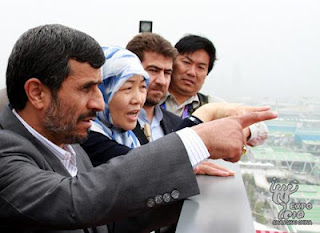China returns to North Pars while problems remain at South Pars
The China National Offshore Oil Corp (SINOC) has announced readiness to restart working on development of Iran's North Pars gas field five years after Iran threatened to cancel the contract due to the Chinese company's repeated delays, the ISNA News Agency said in a report on Monday.
SINOC signed a $16 billion contract in 2007 to develop both the upstream and downstream sections of the North Pars gas field, the Iranian Students' News Agency (ISNA) reports.
SINOC then took no action to start developing North Pars.
Discovered in 1965, the North Pars gas field is 120 kilometers east of the port city of Bushehr in the Persian Gulf.
After waiting for five years, Iran announced that SINOC's contract would be canceled. Now SINOC said that it wants to develop the field. Pars Oil and Gas Company's managing director Mousa Souri says that Iran's Oil Ministry agrees that a contract will be signed.
Meanwhile the fate of Phase 11 of Iran's joint South Pars oil and gas field, which is to be developed by China National Petroleum Corporation (CNPC), is still unknown. CNPC is the only foreign contractor of the South Pars gas field project.
The South Pars gas field is shared by Iran and Qatar. The Iranian share, which is divided into 29 phases, has about 14 trillion cubic meters of gas, or about eight percent of the total world reserves, and more than 18 billion barrels of liquefied natural gas resources. Iran started to develop its section of the field 10 years later than Qatar.
Development of the Iranian section of the gas field started during presidency of Mohammad Khatami. Eight phases of the gas field came on stream during presidency of Mahmoud Ahmadinejad. Development of the phases 9 and 10 began in 2009, but they have not come into operation up to now. The two phases are projected to produce 42 million cubic meters of gas (75 percent of the field's total output).
Next to Russia, Iran is the second holder of gas reserves with over 33 trillion cubic meters of gas reserves. But, it imported some 11.8 billion cubic meters of gas from Turkmenistan last year and exported 9.5 billion cubic meters of gas to Turkey. Therefore, Iran is considered as an importer of natural gas. It is still unknown whether Chinese companies are determined to develop Iranian gas fields or they will continue delaying operations as they did in the past.
** Natural gas flares equal to output of 2 South Pars phases
Problems about Iran's gas industry are not confined to the development of new gas fields as well as phases 11-29 of the South Pars. The Fars News Agency reported on Wednesday that 40 million cubic meters of associated gas as well as 50.96 million cubic meters of light gas are burnt in oil and gas refineries per day.
Associated gas, also known as flare gas, is a form of natural gas, which is commonly found associated with deposits of petroleum. Light gas is referred to the gas which is extracted from condensates or refined gas liquids.
Huge flares of gas to the height of 20-30 meters can be seen at Assalouyeh. Some 7 million cubic meters of light gas is burnt just in the South Pars phases 1-10. The Mehr News Agency reported in 2009 that during 2005-2009, over 64 billion cubic meters of associated gas were burnt at gas fields and refineries.
Associated gases can bring benefits for the country, but they are flared up and drain huge losses to the nation instead. Iran has allocated $2 billion to collect associated gas at the Kharg and Bahregan oil regions, deputy oil minister for engineering affairs said in November 2011.
Hamdollah Mohammadnejad told the Shana news agency that the sum will be spent to collect 17 million cubic meters of associated gas. He added that different projects, worth around $500 million have been developed for collecting up to 99 per cent of associated gases.
Some $15 billion cubic meters of associated gas is burnt at Iran's oilfields, bringing the country around $3 billion of loss annually.
Since 2001, Iran's annual imports of gas have been more than exports by nearly 71 billion cubic meters on average, the Pana news agency reported. Iran is the second major holder of gas deposits in the world.


Comments
Post a Comment